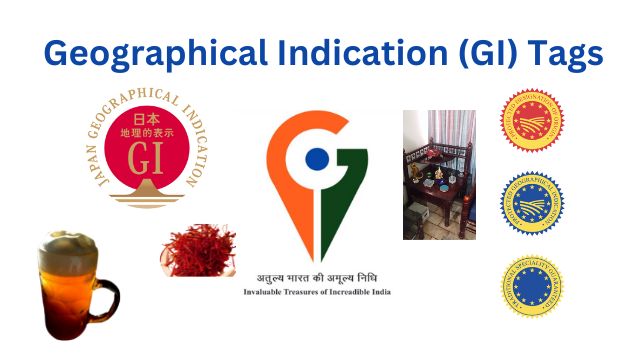
Shivrai coins are a series of historic coins that were issued during the rule of Chhatrapati Shivaji Maharaj, the founder of the Maratha Empire in India. These coins have played an important role in the history of Maharashtra and India.
Geographical indications are an important tool for promoting the reputation of traditional and regional products, protecting intellectual property, and supporting local economies.
World Intellectual Property Organization (WIPO)

Geographical Indication (GI) tags have become an increasingly popular way for consumers to identify and purchase products that are unique to a particular region. A GI tag is a certification that a product possesses a specific quality, reputation, or other characteristic that is linked to the region from which it originates. In this blog, we will explore the concept of GI tags, their benefits, and how they work.

Geographical Indication Tag – What it is?
A Geographical Indication Tag is a certification that a product possesses a specific quality, reputation, or other characteristic that is linked to the region from which it originates. The tag is a form of intellectual property that identifies and protects the reputation of goods produced in a specific region.
To obtain a GI tag, a product must meet certain criteria, such as having a unique production process, being produced in a specific geographical area, and having a reputation that is linked to that area. Once a product is certified with a GI tag, it becomes part of a regional brand that is recognized by consumers and can be used as a marketing tool to promote the product.
GI Tags – What are the benefits?
GI tags provide several benefits for both producers and consumers. For producers, a GI tag can help to protect their product’s reputation, prevent counterfeiting, and create a unique selling point. By linking their product to a particular region, producers can also benefit from the region’s cultural heritage and promote the area’s economy.
For consumers, GI tags provide assurance of quality and authenticity. Consumers can be confident that they are buying a product that has been produced using traditional methods and that the product is unique to a particular region. The tag also helps consumers to make an informed choice and supports local communities and economies.
GI Tags How it works?
To obtain a GI tag, a producer must apply to a certification agency that has been authorized by the government to issue GI tags. The agency will evaluate the product to ensure that it meets the necessary criteria for a GI tag, such as being produced in a specific geographical area or having a unique production process. If the product meets the criteria, the agency will issue a GI tag that the producer can use to market and promote their product.
In some cases, the GI tag is attached to the product itself, such as in the case of wines and spirits. In other cases, the tag is a label or logo that is used to identify the product and its origin.
How to get GI tags?
Member countries of the World Trade Organization and their nationals are increasingly recognizing that GIs are valuable as marketing and protection tools in the global economy. In India, GI tags are issued as per the Geographical Indications of Goods (Registration and Protection) Act,1999. To get a Geographical Indication (GI) tag for a product, the producer or group of producers who want to apply for it need to follow certain steps. The tag is issued by the Geographical Indication Registry under the Department of Industry Promotion and Internal Trade, Ministry of Commerce and Industry.
Identify the product: The first step is to identify the product for which the GI tag is to be applied. The product should have a unique quality or reputation that is linked to the region from which it originates.
Form a group: The producers of the product must form a group or an association that represents the product and its origin. The group must have a legal identity and should be registered under a relevant act or law.
Apply for GI tag: The group can apply for a GI tag by submitting an application to the Geographical Indication Registry office. The application must include the following information:
Examination of the application: The application is examined by the Geographical Indication Registry office to ensure that it meets the necessary criteria for a GI tag. If the application is found to be in order, the Geographical Indication Registry office will publish the application in the Geographical Indications Journal.
Objections: If there are no objections to the application within the specified period, the GI tag is granted. However, if there are any objections, the matter is referred to the Intellectual Property Appellate Board.
Registration of GI tag: Once the GI tag is granted, the product can be registered under the Geographical Indications of Goods (Registration and Protection) Act, 1999. The registration provides legal protection to the product and its origin.
Geographical Indication (GI) tags are an important tool for promoting and protecting traditional products from specific regions. They provide several benefits for both producers and consumers, including protecting the reputation of the product, preventing counterfeiting, and promoting local economies. By linking a product to a specific region, GI tags create a unique selling point that can be used to market and promote the product. As consumers become increasingly interested in supporting local communities and purchasing high-quality, authentic products, the use of GI tags is likely to become even more widespread.
Image credit:

Shivrai coins are a series of historic coins that were issued during the rule of Chhatrapati Shivaji Maharaj, the founder of the Maratha Empire in India. These coins have played an important role in the history of Maharashtra and India.

Silver has been a popular material for crafting since ancient times, and its use has been documented across many different civilizations. In ancient Rome, for example, silver was used to create beautiful pieces of jewelry and objects for everyday use.

The history of Chunar glaze pottery can be traced back to the Mauryan period in India, which lasted from 321 BC to 185 BC. During this time, the town of Chunar was an important center for pottery production.